6 Patio Cover Types to Shade You in Style
Most of us love that casual, barefoot, inside-outside lifestyle that big windows and doors and a patio or deck can provide. And for much of the year, a wonderful outdoor space connected to a home makes for a terrific living area.
But when it's really warm out, uncovered outdoor spaces aren't all that much fun, especially if they are on the south side of the house. At times like these, the only way to get any use from that beautiful deck or patio is to have something, anything, that will block the sun from baking everyone and everything out there.
And like everything else in home design, the type and style of your patio or deck covering will be a function of your house's style, the solar orientation the outside space has and your budget. Let's take a look at a few options to see what could work for you.
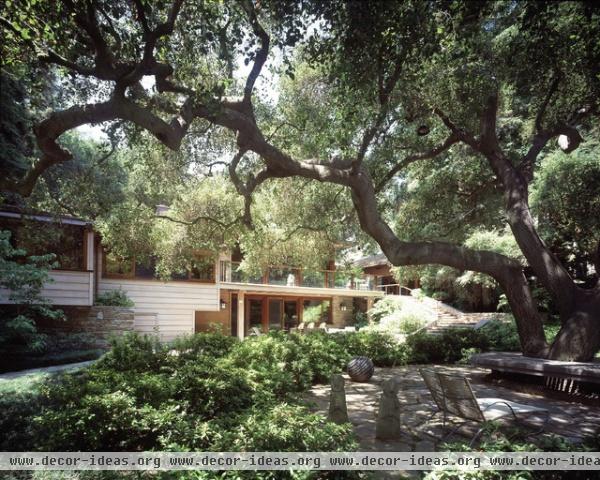
Shade tree. Before going on about built patio and deck canopies, we should acknowledge that trees are the best for providing that canopy naturally. Especially deciduous trees that are all filled out, providing the most shade exactly when it's most needed. Then, just as the dog days of summer start to wane, these trees start to lose their leaves, becoming bare in winter, when getting as much sun on the area is what's desired. In fact, the cyclical pattern of a deciduous tree going from bare to full bloom is one of nature's gifts that never ceases to amaze.
Alas, not all of us have some wonderful old tree to build a patio under, nor do we have the decades that it would take to get a tree to start shading our patio. In these instances, you should plant some trees and create a built shading device while you wait for nature to take its course. Some umbrellas or a pergola will do nicely until some beautiful tree joins the party.
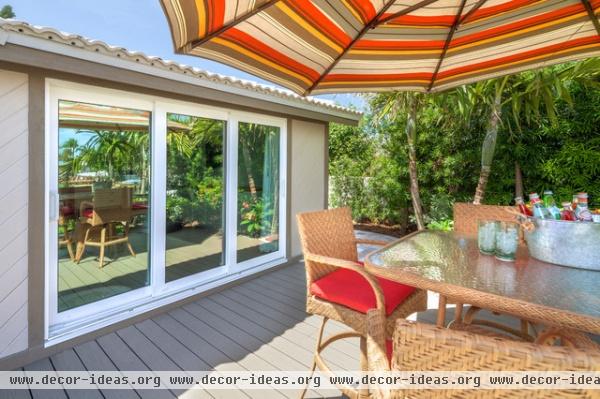
Umbrella. The most basic patio or deck cover is the freestanding umbrella. Whether grouped with a table or a chair, providing shade while you're outside having lunch or a morning coffee — or, better yet, a midafternoon quaff — a bright and colorful umbrella can add a splash of color and zest to an outdoor space while providing some relief from the hot summer sun. While there are many umbrellas that are part of the table, in which a hole for the umbrella pole is provided, I've always preferred umbrellas that can be easily moved — that way you can block the hot sun from any direction it comes from.
Of course, a nice thing is that umbrellas can be had for little money, typically in the range of a few hundred or so dollars for a nice one that will provide many years of shade. It's also neat that you can integrate LED lighting within the umbrella canopy. While these lights won't illuminate an entire outdoor space, they'll shed some nice lighting onto the table surface, just where it's needed.
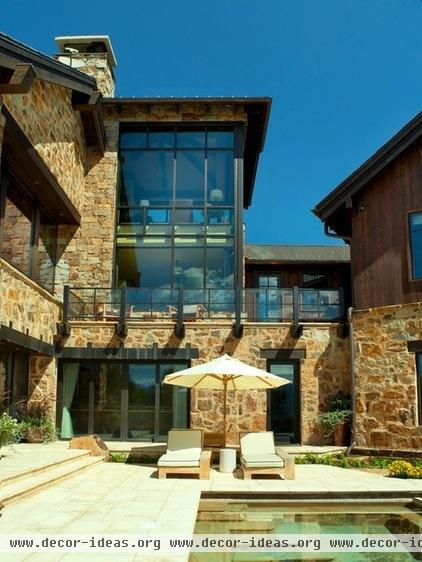
Umbrella mobility means you'll always have shade where you want it as the sun moves across the sky. Freestanding umbrellas either have a straight pole rising from a base, or the umbrella is offset. With an offset umbrella, the arm that holds the actual umbrella can be raised, lowered, angled and generally manipulated in a number of ways to get the shading exactly where you want it. This is ideal where there's room, as the base can be kept away from the table or chairs and won't block your way on the patio or deck.
As for materials, the poles are generally either aluminum or wood, and the umbrella fabric can be a range of materials. When looking at umbrella fabrics, things to consider will be ease of cleaning, durability, fade resistance, UV protection, mold and mildew resistance, and water resistance.
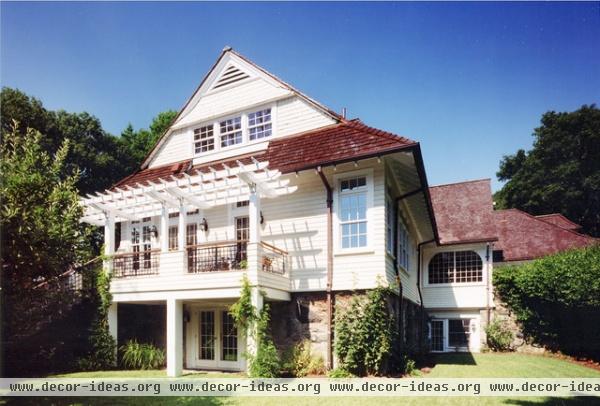
Pergola. At the opposite end of the spectrum from the movable and casual umbrella are built structures, which can come in many styles and sizes and at a range of costs.
For a more traditional style, a custom pergola of columns, rafters and purlins is the answer. These provide a real sense of having a room outside that's open to the sky and air and nature, while still being very much a part of the home.
While the cost of such a structure can vary widely depending on style, size, finishes etc., expect that you'll be well into a five-figure budget for one. And don't forget that you'll more than likely need a building permit to construct one as well.
These structures need ongoing maintenance, unlike a temporary umbrella, which gets put away after the season. Using low-maintenance materials, such as acrylic trim boards, fiberglass columns and woods such as ipe and redwood, will mean you'll be out there enjoying yourself rather than cleaning, scraping and painting.
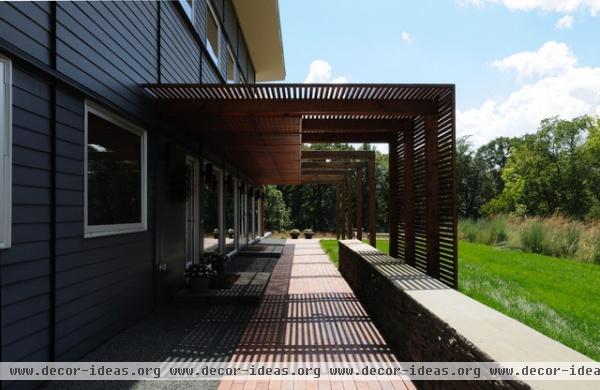
Lattice. If your home is more contemporary, a lattice-like covering could be a nice addition. Unlike the traditional pergola, a lattice-like structure has thinner and more simply shaped pieces, and forms a more rectangular structure. For a structure like this, using a durable wood is the key to getting many, many years of enjoyment from the space. While a wood like cedar is good, paying extra for something like redwood or teak will pay dividends in durability over the years.
In fact, one of my favorite outside woods, especially when it's left to weather to that beautiful silvery gray, is teak. Sure, you can sand and varnish teak every few years, but I'd rather just enjoy my patio.
Adding fabric to the lattice structure will provide some flexibility for shading control as well as soften up its overall aesthetics.
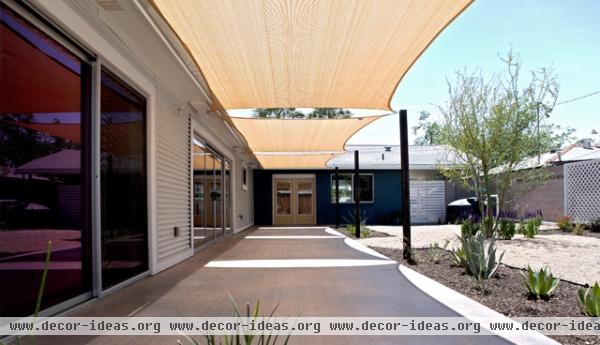
Cloth. A detailed and expansive structure isn't necessary for some simple sail-like shades. While you can easily spend thousands of dollars on a sophisticated shading system with guide wires and the like, a few posts, some wires and fabric will set you back a minimal amount of money and be a really nice way to shade the patio.
As with the umbrellas, doing some research into the material for the shades is important. And make sure that the cloth is pitched to allow rainwater to fall off of it. Without that pitch, rainwater can puddle up in the middle of the cloth sail, causing the fabric to stretch and be ruined — or, worse, causing the whole system to collapse because of the weight of the water.
And make it so you can easily take down the fabric canopy and store it for the winter, especially in climates that get ice and snow.
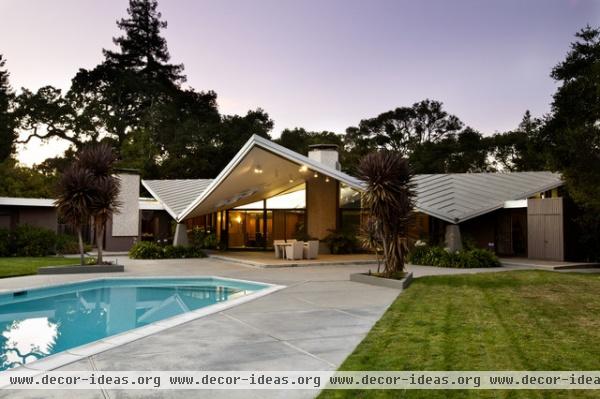
Totally integrated. If budget and architecture allow, consider a shading system that is totally integrated into the design of the home — something that carries on the roof forms and simply eliminates that exterior walls.
While this is the most costly option, it could very well be the most satisfying, given the right circumstances. And the most useful, too, as no matter what the weather is, the space under the roof will always be dry and ready to be inhabited.
Have an ingenious patio cover? Please shoot a photo and share your design below!
More: How to work with nature's elements for the best outdoor space












